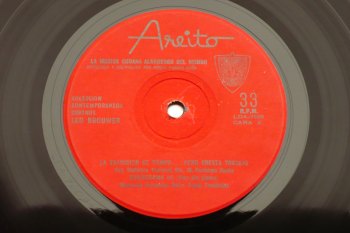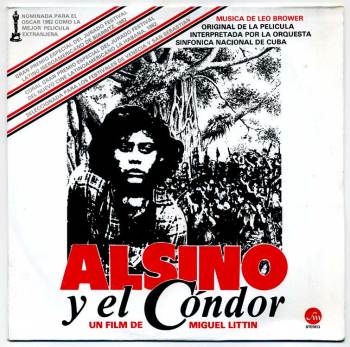Cuban composer Leo Brouwer, born 1939, was exposed at an early age to Western contemporary and serial music, first in the 1960s while he studied at New York’s Julliard school, and as a visitor during Warsaw’s Autumn Festival in 1961 in Poland, until he became lecturer at Berlin’s Academy of Science and Arts in 1972. Published in the legendary Coleccion Contemporaneos Cubanos series – which later changed its name to Contemporaneos in the 1980s–, this is probably Brouwer’s first orchestral music recording and a first attempt at a musical sincretism combining Western music with a Cuban idiom. The motto “La musica cubana alrededor del mundo”, or Cuban music around the world, on the record’s label is an indication of such a project. All pieces on this disc date from the 2nd half of the sixties.
♫ Composed in 1967-69 for large orchestra, the opener La Tradicion Se Rompe… Pero Cuesta Trabajo is a vast collage of Western classical and contemporary music (Bach, Beethoven, etc). In his desire to create a musical “magma”, Brouwer mixes a lot of things, and the piece is perhaps more a manifesto a la Luigi Nono, than a real musical exploration. Sonograma III, for 2 pianos, 1968, is a handsome, semi-aleatoric composition for two pianists where indeterminacy is used to create complex, intertwining lines. In Conmutaciones, 1966, the three percussionists move from one instrument to the next around the stage, in a series of lively and playful combinations. Composed 1965, the last work on this disc, Dos Conceptos del Tiempo, for ten players, is an example of Serial music for small ensemble. The sound palette includes electric organ, celesta and xylophone, in addition to winds, strings and piano, contributing to a very approachable music with a typical, warm Cuban sound.
- La Tradición Se Rompe… Pero Cuesta Trabajo (13:32)
Orquesta Sinfónica Nacional De Cuba
Manuel Duchesne Cuzán, conductor - Sonograma III (7:15)
Frank Fernández, piano
Ninowska Fernández-Britto, piano - Conmutaciones (5:42)
Leo Brouwer, percussion
Carlos Fariñas, piano, celesta
V. Savtcheva, xylophone, vibraphone, percussion - Dos Conceptos Del Tiempos (11:10)
Orquesta Sinfónica Nacional De Cuba
Leo Brouwer, conductor
Total time 37:39
LP released by Areito, ref. LDA 7009, La Habana, Cuba, early 1970s
* *
*






















